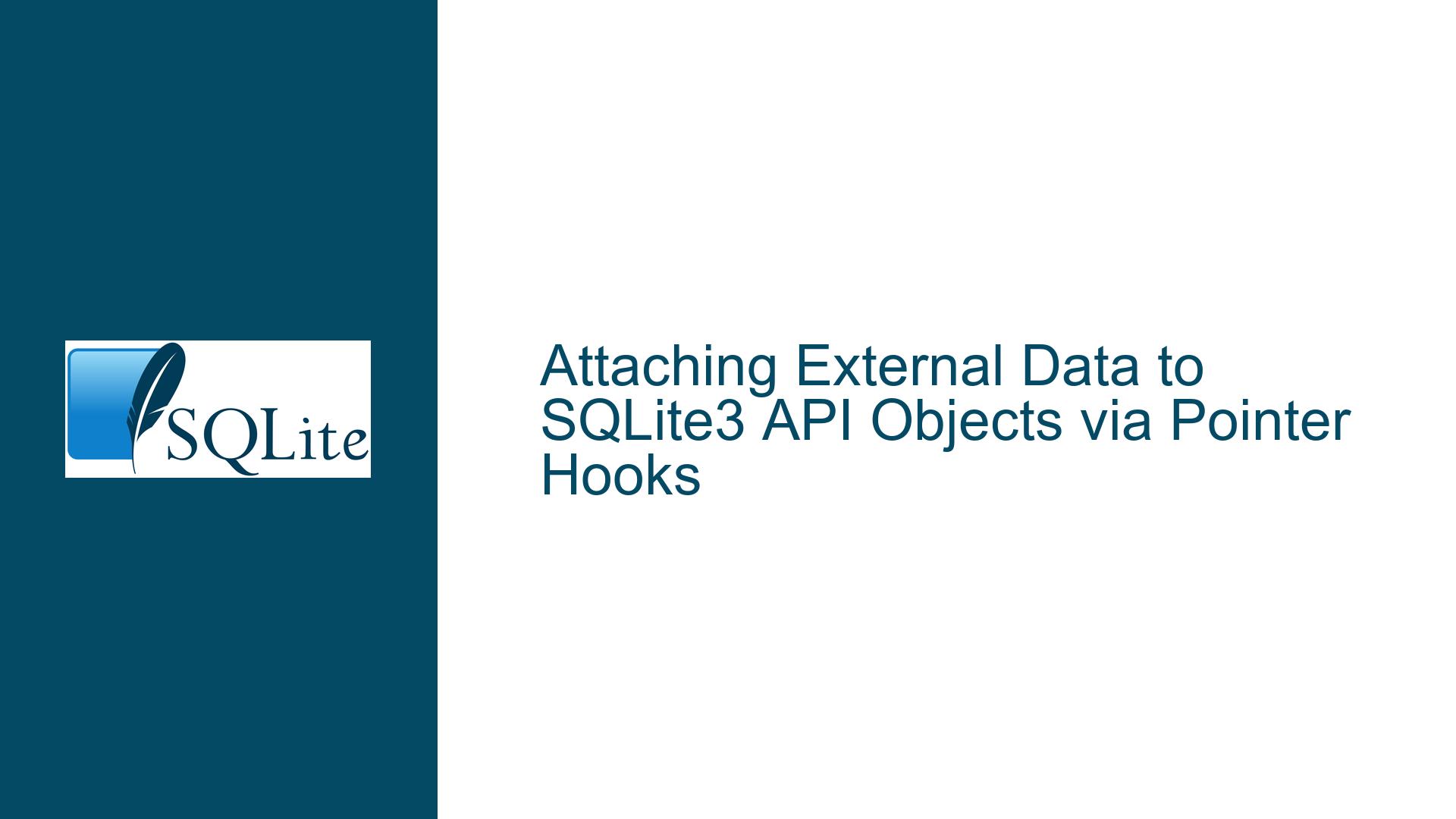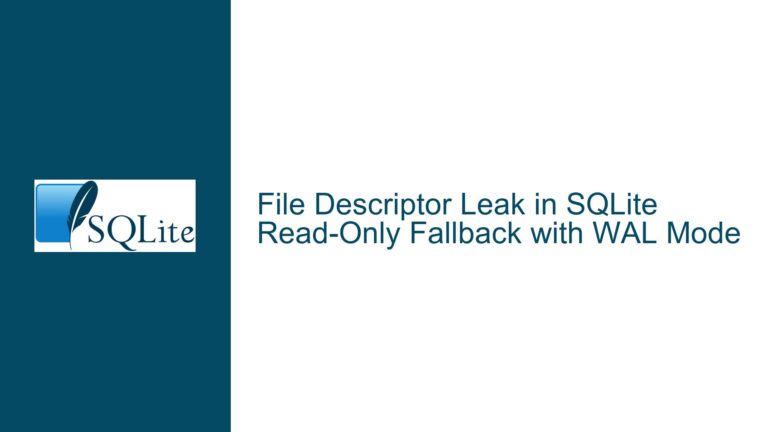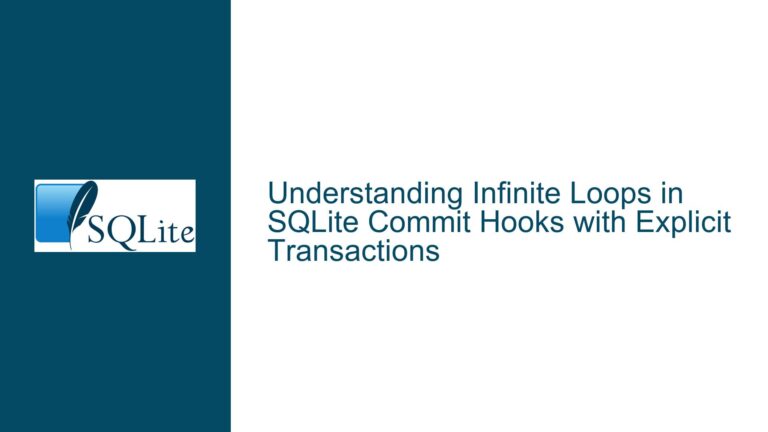Attaching External Data to SQLite3 API Objects via Pointer Hooks
Understanding Pointer Attachment to SQLite3 API Data Types
Issue Overview: Associating External Data with SQLite3 API Objects
The core challenge revolves around associating external data (a "shadow object") with SQLite3 API data types such as sqlite3_value without storing this data in the database itself. The goal is to create a persistent link between a sqlite3_value object (returned by functions like sqlite3_value_dup) and a user-defined structure in an external programming language. This linkage must survive across multiple interactions with the same sqlite3_value object, enabling efficient retrieval of the shadow object without recreating it each time.
SQLite3 API objects like sqlite3_value are transient entities managed by SQLite’s internal memory system. They represent values during query execution, such as parameters passed to user-defined functions or results returned from them. The problem arises when an external program needs to maintain stateful metadata (the shadow object) tied directly to these transient SQLite3 objects. For example, a wrapper library for SQLite3 in another language might need to track language-specific context (e.g., Python objects, JavaScript handles) associated with a sqlite3_value as it flows through SQLite’s internal operations.
The critical constraints are:
- No Database Storage: The shadow object must not be serialized into the database.
- Lifecycle Synchronization: The shadow object must persist as long as the associated
sqlite3_valueexists and be destroyed when thesqlite3_valueis released. - Pointer Integrity: Memory addresses (pointers) stored in the
sqlite3_valuemust remain valid across the external program’s execution context.
Possible Causes: Misalignment with SQLite3 Memory Management and API Capabilities
The inability to directly attach a shadow object to a sqlite3_value stems from SQLite3’s design principles and memory management constraints. Below are the primary factors contributing to this issue:
Opaque Internal Representation: SQLite3 deliberately abstracts the internal structure of objects like
sqlite3_value. Users interact with these objects via API functions, not direct memory access. This encapsulation prevents arbitrary data injection into the object’s memory space.Lack of Native Hook Support: Unlike libraries such as libconfig, SQLite3 does not provide built-in functions like
config_setting_set_hookorconfig_setting_get_hookto attach arbitrary data to API objects. SQLite3’s API focuses on data manipulation and query execution, not extensibility via user-defined metadata.Pointer Lifetime Mismatch: Storing raw pointers (memory addresses) in
sqlite3_valueobjects is inherently unsafe because:- SQLite3 might duplicate or destroy
sqlite3_valueobjects unpredictably (e.g., during query optimization or garbage collection). - Pointers retrieved from one process or thread are meaningless in another due to address space isolation.
- SQLite3 might duplicate or destroy
Misuse of Existing Pointer Mechanisms: SQLite3 provides limited pointer-passing mechanisms like
sqlite3_bind_pointerandsqlite3_result_pointer, but these are designed for specific use cases (e.g., binding application-owned pointers to query parameters). Misapplying these functions to attach data tosqlite3_valueobjects leads to undefined behavior or runtime errors.Shadow Object Lifecycle Management: Even if a pointer could be embedded in a
sqlite3_value, managing the shadow object’s lifecycle (allocation, deallocation, thread safety) requires tight integration with SQLite3’s memory subsystem, which is not exposed to the user.
Troubleshooting Steps: Binding External Data to SQLite3 API Objects Safely
To resolve this issue, developers must work within SQLite3’s API constraints while achieving the functional goal of shadow object association. Below is a structured approach:
Step 1: Use SQLite3’s Pointer-Passing Mechanisms Correctly
SQLite3 provides two primary mechanisms for handling pointers:
sqlite3_bind_pointer: Binds a pointer to a parameter in a prepared statement.sqlite3_result_pointer: Returns a pointer as the result of a user-defined function.
While these functions are not directly applicable to attaching data to sqlite3_value objects, they can be repurposed with careful design:
- Scenario: A user-defined function creates a
sqlite3_valueand needs to attach a shadow object.- Solution: Use
sqlite3_result_pointerto return the shadow object’s pointer as part of the function result. SQLite3 will associate the pointer with the returned value, allowing retrieval viasqlite3_value_pointerin subsequent interactions.
- Solution: Use
// Example: Returning a pointer from a user-defined function
void my_function(
sqlite3_context *context,
int argc,
sqlite3_value **argv
) {
// Create shadow object
ShadowObject *shadow = create_shadow_object();
// Return pointer to shadow object
sqlite3_result_pointer(context, shadow, "ShadowObject", destroy_shadow_object);
}
// Retrieving the pointer in another function
void another_function(
sqlite3_context *context,
int argc,
sqlite3_value **argv
) {
ShadowObject *shadow = sqlite3_value_pointer(argv[0], "ShadowObject");
if (shadow) {
// Use shadow object
}
}
- Key Considerations:
- Type Tag: Use a unique type tag (e.g.,
"ShadowObject") to avoid pointer type collisions. - Destructor: Specify a destructor function (
destroy_shadow_object) to free the shadow object when SQLite3 releases the associated value.
- Type Tag: Use a unique type tag (e.g.,
Step 2: Manage Shadow Object Lifecycle with SQLite3’s Memory Subsystem
To ensure shadow objects are destroyed when their associated sqlite3_value is released, integrate custom memory management with SQLite3’s allocator:
- Override SQLite3’s Default Destructor:
- When using
sqlite3_result_pointer, the specified destructor is invoked when thesqlite3_valueis destroyed. This ensures the shadow object is deallocated correctly.
- When using
// Destructor for shadow object
void destroy_shadow_object(void *ptr) {
ShadowObject *shadow = (ShadowObject *)ptr;
// Cleanup logic
free(shadow);
}
- Handle Duplicate Values:
- When duplicating a
sqlite3_valueviasqlite3_value_dup, the new value shares the same pointer. This can lead to double-free errors if both values are destroyed. To mitigate this:- Implement reference counting in the shadow object.
- Increment the reference count when duplicating the value.
- Decrement the reference count in the destructor and free the object when the count reaches zero.
- When duplicating a
typedef struct {
int refcount;
// Other shadow data
} ShadowObject;
void destroy_shadow_object(void *ptr) {
ShadowObject *shadow = (ShadowObject *)ptr;
shadow->refcount--;
if (shadow->refcount == 0) {
free(shadow);
}
}
// When duplicating a value with an existing shadow object
ShadowObject *original_shadow = sqlite3_value_pointer(value, "ShadowObject");
original_shadow->refcount++;
sqlite3_result_pointer(context, original_shadow, "ShadowObject", destroy_shadow_object);
Step 3: Bridge External Language Bindings with SQLite3’s API
When integrating SQLite3 with an external language (e.g., Python, Java), additional layers are required to map between language-specific objects and SQLite3’s pointer-passing system:
- Python Example:
- Use a global registry to map pointers to Python objects.
- Leverage Python’s
ctypesmodule to handle pointers.
import ctypes
import sqlite3
# Global registry for shadow objects
shadow_registry = {}
class ShadowObject:
def __init__(self, data):
self.data = data
def my_function(context, *args):
# Create Python shadow object
shadow = ShadowObject("example")
# Convert Python object to a C pointer
address = id(shadow)
shadow_registry[address] = shadow
# Return pointer as integer
context.result_pointer(address, "ShadowObject")
def another_function(context, *args):
# Retrieve pointer from SQLite value
address = context.value_pointer(0, "ShadowObject")
shadow = shadow_registry.get(address)
if shadow:
print(shadow.data)
# Register functions with SQLite
conn = sqlite3.connect(":memory:")
conn.create_function("my_function", 0, my_function)
conn.create_function("another_function", 1, another_function)
cursor = conn.execute("SELECT another_function(my_function())")
- Key Considerations:
- Pointer Stability: Ensure the external language does not relocate or garbage-collect the shadow object prematurely.
- Thread Safety: Use thread-local storage or synchronization primitives if the registry is accessed concurrently.
Final Note: While attaching external data to SQLite3 API objects is feasible via pointer-passing and lifecycle management, developers must rigorously validate the approach against SQLite3’s version-specific behavior and the external language’s memory model. Testing for edge cases (e.g., rapid object creation/destruction, multi-threaded access) is essential to prevent memory leaks or corruption.






